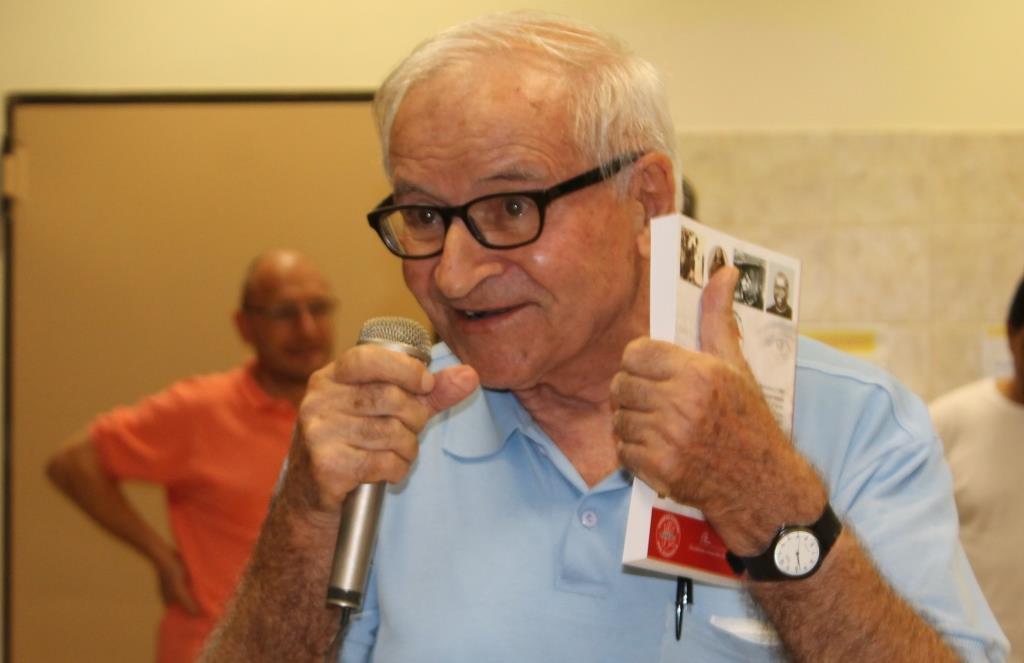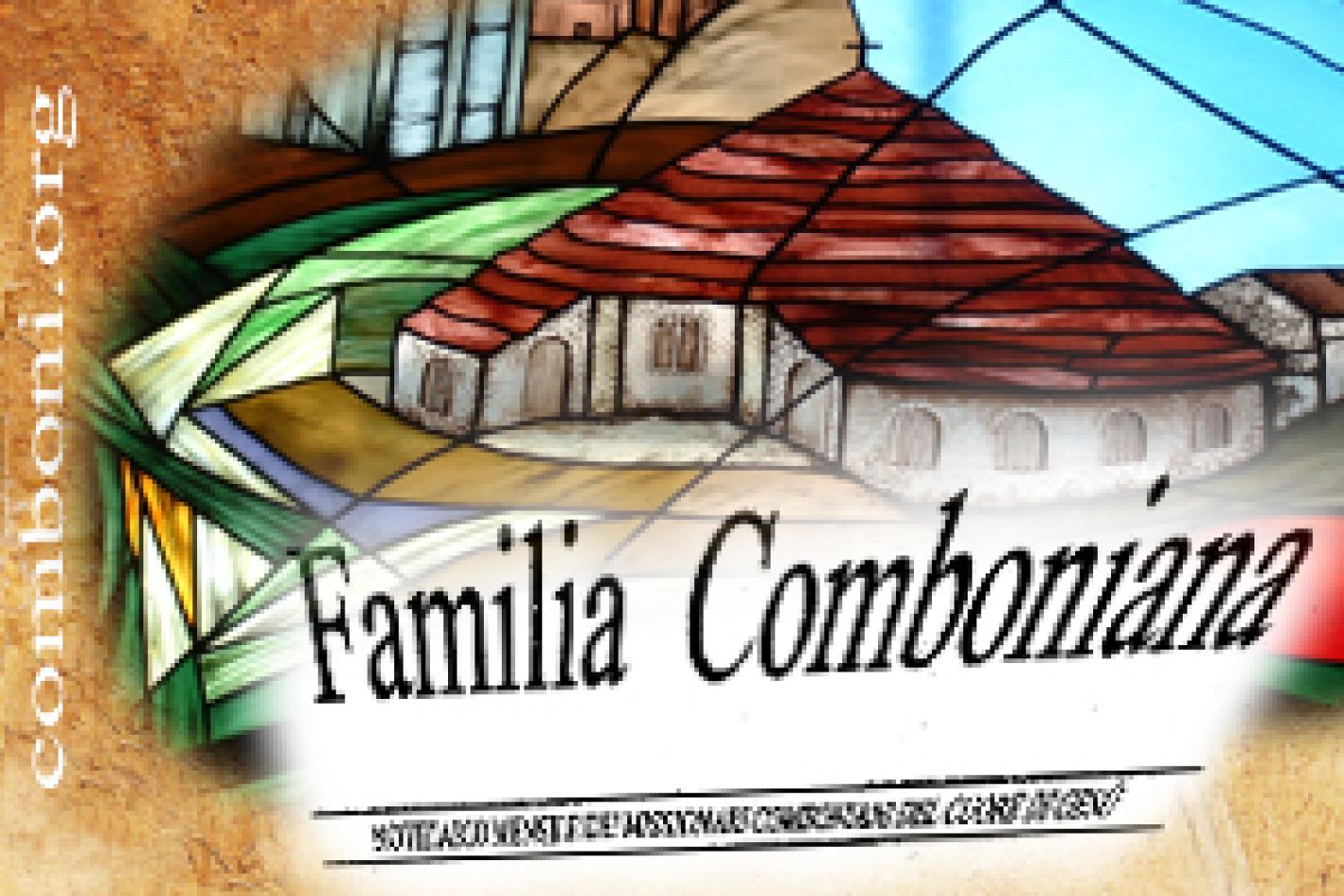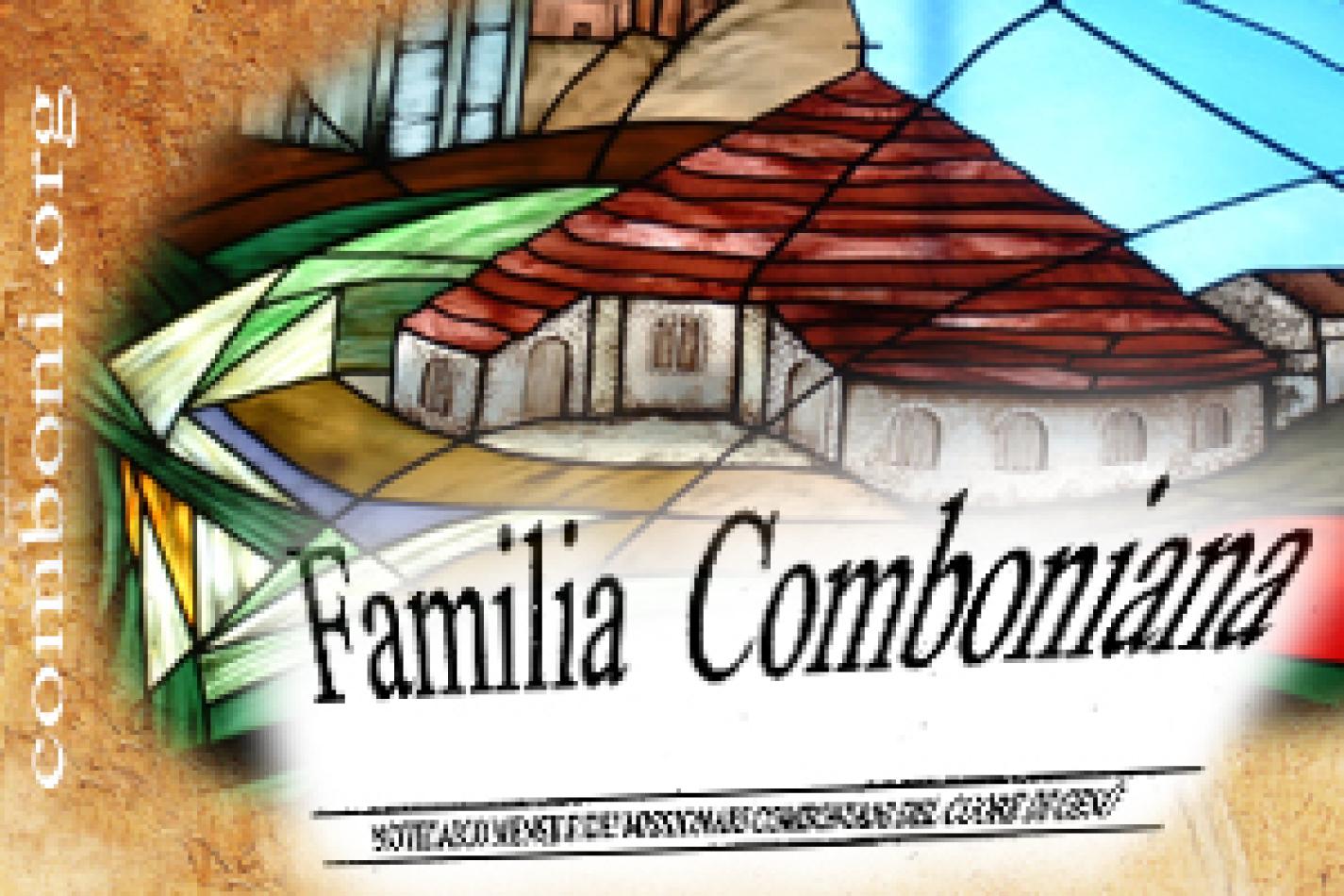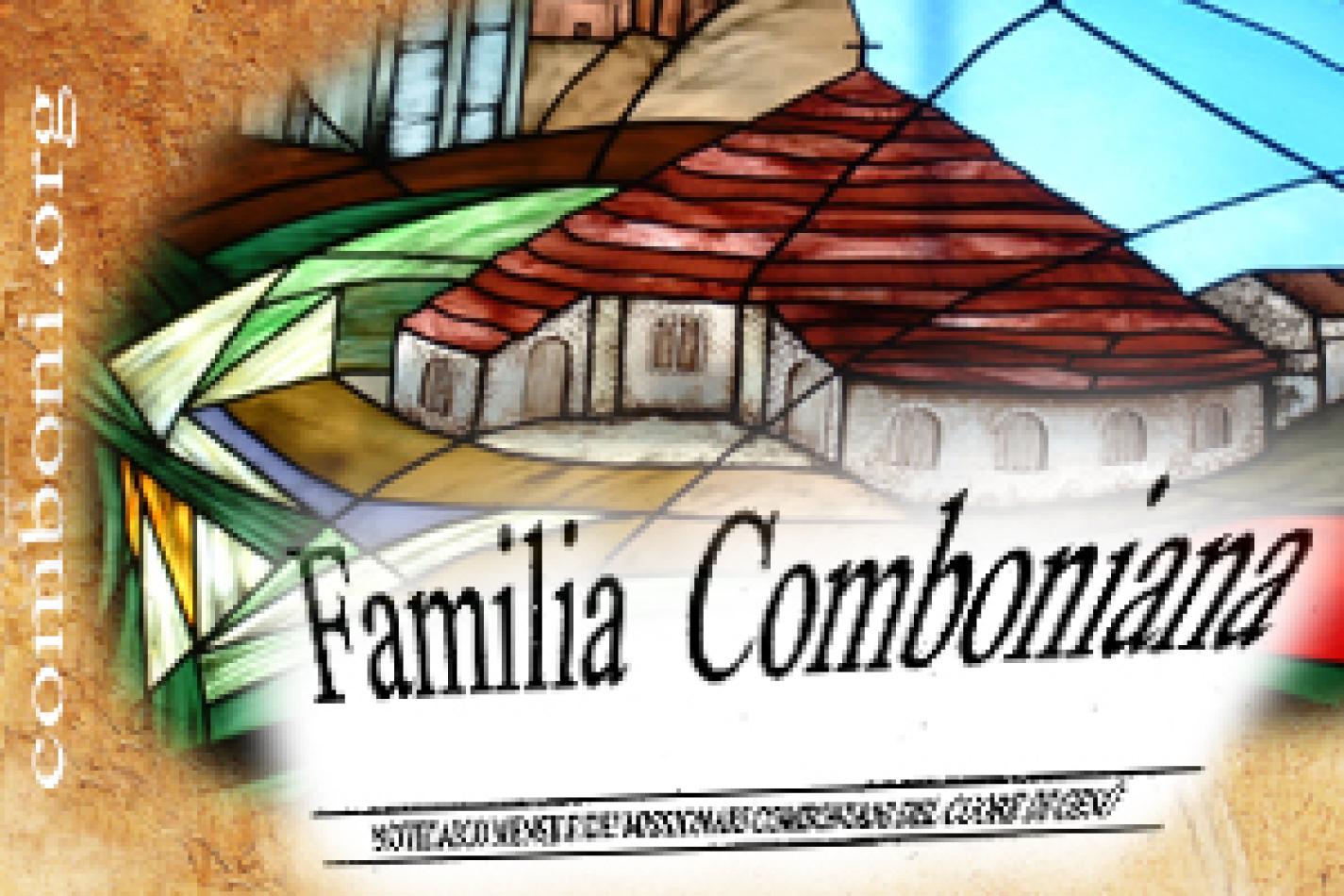Daniel Comboni
Comboni Missionaries
Institutional area
Other links
Newsletter
Monday, February 9, 2015
On 21 November, 2014, Pope Francis wrote an Apostolic Letter to All Consecrated People on the occasion of the Year of Consecrated Life to begin on 30 November, 2014, the first Sunday of Advent, and conclude with the Presentation of Jesus in the temple, on 2 February, 2016. Taking the themes of the letter from what Pope John Paul II had written in his Post-Synodal Exhortation Consecrated Life (no, 110), Pope Francis invited the consecrated people: “to look to the past with gratitude,” “to live the present with passion” and “to embrace the future with hope”. I have been asked to share a reflection on the first part of the letter of Pope Francis with a grateful look at our past as consecrated Combonians. In the picture: Fr. Salvatore Pacifico.
Comboni missionaries
of the Province
of Central America.
1. THE POPE’S WORD
Pope Francis wrote: “All our Institutes are heir to a history rich in charisms. At their origins we see the hand of God who, in his Spirit, calls certain individuals to follow Christ more closely, to translate the Gospel into a particular way of life, to read the signs of the times with the eyes of faith and to respond creatively to the needs of the Church. This initial experience then matured and developed, engaging new members in new geographic and cultural contexts, and giving rise to new ways of exercising the charism, new initiatives and expressions of apostolic charity. Like the seed which becomes a tree, each Institute grew and stretched out its branches.” “During this Year”, Pope Francis continued, “it would be appropriate for each charismatic family to reflect on its origins and history, in order to thank God who grants the Church a variety of gifts which embellish her and equip her for every good work” (cf. Lumen Gentium, 12). “Rather than an exercise in archaeology or the cultivation of mere nostalgia, it calls for following in the footsteps of past generations in order to grasp the high ideals, and the vision and values which inspired them, beginning with the founders and foundresses and the first communities. In this way we come to see how the charism has been lived over the years, the creativity it has sparked, the difficulties it encountered and the concrete ways those difficulties were surmounted. We may also encounter cases of inconsistency, the result of human weakness”. Pope Francis concludes: “May this Year of Consecrated Life also be an occasion for confessing humbly, with immense confidence in the God who is Love (cf. 1 Jn 4:8), our own weakness and, in it, to experience the Lord’s merciful love. May this Year likewise be an occasion for bearing vigorous and joyful witness before the world to the holiness and vitality present in so many of those called to follow Jesus in the consecrated life.”
2. THE FOUNDER
2.1 The passion for the mission
If we were to ask ourselves what the most important legacy our Founder has left us is, I would say that it is the passion for the mission. In the past it was the passion for Africa. Comboni liked to call himself an “Apostolic Missionary”, paraphrasing St Paul: “Called to be an apostle, chosen for the service of the Gospel ... to bring all nations to the obedience of the faith” (Rm 1, 1-5). The passion for the mission has marked the history of our Institute. We are aware that the first cases of friction in the Institute, after the death of Comboni and after the Institute had been transformed into a religious Institute with vows, occurred precisely at this level. When the new members of the Institute, “Sons of the Sacred Heart of Jesus”, arrived in Africa, the old missionaries of Comboni had the impression that the conventual dimension had prevailed over the missionary dimension, and they reacted. The crisis did not last long because, after some time, the “Sons of the Sacred Heart” were the only ones left in the field. Comboni was willing to turn a blind eye to other limits of his missionaries but not to this one. The passion for the mission was the pillar that sustained all his basic motivation.
2.2 Sound formation
The other important element was sound formation. Passion for the mission and sound spirituality went together in the thinking of Comboni. Passion for the mission would not have been genuine and would not have lasted long unless it was sustained by a strong spirituality. In his Rules of 1871, he wrote: “To those who aspire to the African apostolate it is important and necessary that they should have solid dispositions of genuine zeal, of pure love and fear of God and that they should maintain a firm control over their passions. To this end, while there should always be in the Institute a spirit of simplicity, cheerfulness and a lively atmosphere, there must also be a strong fervour for the things of the spirit, the study of the interior life and a lively desire for perfection” (W 2706). And again we read in the Rules of 1871: “When the missionary in Africa has a heart burning with the pure love of God, when he keeps his eyes fixed on the contemplation of the great goodness and loftiness of the work for which he spends himself, then all the privations, the continuous hardships, the greatest trials become a paradise on earth for his heart, then the cruellest of martyrdoms and death itself become the dearest and most eagerly desired reward for his sacrifices” (W 2705). Among the virtues of the missionary, Comboni attached great importance to “the spirit of sacrifice”, about which he wrote: “They will develop in themselves this most essential disposition by keeping their eyes firmly fixed on Jesus Christ, loving him tenderly and seeking always to understand more fully the meaning of a God who dies on the cross for the salvation of souls” (W 2721). I believe that, in this regard, it was indeed providential that the Jesuits should be present at the beginning of the new congregation. They gave that sound formation that Comboni had always desired. It was certainly due to the first Comboni Missionaries in the mission fields that the fruitful synthesis between passion for the mission and spirituality was made. The danger of a spirituality lived in a conventual way was easily overcome “in the field”.
While we are considering formation, we cannot ignore the evolution that has taken place in this sector in the Institute, especially since Vatican II. We shall come back to this point later.
2.3 It is the mission that indicates what to do and how to do it
This principle is to be found at the beginning of the Rules of 1871. “In order to be of lasting value, the Rules of an Institute which is to train apostles for unbelieving peoples must be based on general principles... those general principles must so inform his mind and heart that he is able to make decisions by himself, by applying them diligently and with discretion to the times, the places and the most varies circumstance in which his calling may place him” (W 2640, 2641). And besides this, even if the rules “are the result of serious reflection, of long study, of careful consideration and of full knowledge of the situation in question, since they deal with a great and formidable mission which is altogether new and special, it will be useful to await the results of practical experience that time will provide.” (W 2643). In other words, Comboni was telling his missionaries that it is the mission itself, in its concreteness and variety, that shows the missionary what choices to make (what to do), and how to carry them out (how to do it), always ready to change course if it should show itself to be inconsistent or no longer valid due to changes in the field. This required much attention to history and its development – what Vatican II would call “the signs of times”. We know that Comboni was exemplary in this matter. The Plan was the fruit of his attentive reading of the reality. And the changes he made in the various editions of The Plan were suggested by an analysis of the evolving situations.
2.4 The community
This was another pillar among the guidelines given by Comboni to his missionaries which is still maintained in the practice of the Institute and bearing fruit. I here quote what he wrote to Cardinal Barnabò in 1873 as Provicar Apostolic of Central Africa: “If I did not know that Your Eminence has experienced in other Missions the regretful consequences of Vae soli (misfortune to the solitary), I would be urging you with the most vehement solicitude never to leave a mission in the care of only one or two missionaries” (W 3189). Three years later he reacted strongly to the proposal of Carcereri who suggested increasing the number of mission stations and cited the names of “Scellal, Berber, Khartoum, Gebel Nuba, Cordofan (El Obeid), Sennar, Fascioda: to build little huts there and to settle just one missionary there with a layman in each. This plan was not accepted by me”, Comboni wrote to Cardinal Franchi of Propaganda Fide. He lists concrete motives from the material to pastoral, moral and spiritual aspects (W 4241). Already, in 1865, commenting on the fact that a Franciscan had been left alone in Khartoum for a period of three years, he wrote to Cardinal Barnabò: “I will never be able to approve the system of leaving a missionary alone, without the means of defending himself with the shield of the Sacrament of Penance in so remote and perilous an area” (W 1317). In the history of our Institute, up to the present day, there have not been lacking proposals to allow missionaries to live alone since this would have allowed an increase in presence and service. Comboni and the Institute have always opposed this. Furthermore, I would say that community life, with its corollary of fraternal charity, was, for a long time, the banner of the Institute, continually recalled by the General Superiors. We know that, with the passing of time, the mission field was extended to Latin America, many countries of Africa and finally to Asia. Communities of formation and mission promotion have been opened in many places in all the continents. The concept of mission itself has seen development. However, it seems to me that these basic Comboni orientations have remained fundamental and have guaranteed consistency and continuity even as circumstances changed.
Comboni missionaries
of the Province
of Uganda.
3. COMBONI MISSIONARIES IN MISSION
Catechumenate, safaris and the formation of catechists
Let us place ourselves in the shoes of the Comboni Missionaries who, in the early 1900’s, when the Mahdi revolt had ended, arrived in mission land, specifically the Sudan and northern Uganda. They had to start from scratch, working in what was, to them, an unknown land. They began by acquiring the tools for the work: the language, above all, in order to communicate, and knowledge of the customs of the people in order to communicate sensibly. We know that our missionaries worked miracles, with excellent results that would benefit the hundreds of missionaries who arrived afterwards. And not only them. Of course, there were uncertainties. One of the first debates took place between those who, faced with the human poverty of the people to be evangelised, suggested the principle “first human beings and then Christians”, and those who wanted to begin with Christian formation. This is the policy which prevailed, in the conviction that it is religion itself that makes room for human growth. Once this choice was made, a methodology was found with two basic elements, the catechumenate and the safari, which played a determining role where Comboni missionaries started from scratch.
3.1 The catechumenate
The catechumenate consisted of much more than learning the catechism of Pius XII by heart. The catechumens spent long periods at the mission, took part in community prayers, and experienced life in a group in a Christian context, even if this was limited. They saw with their own eyes the activities and the life of the missionaries. They understood that the mission was also theirs: they contributed with their labour to their upkeep and the general expenses of the mission. The catechumenate did not end with baptism. After baptism, the catechumens spent two more months at the mission for the mystagogical phase, the aim of which was to reach an understanding of what happens when baptism is received and how to live it in their lives. Three times a year (Christmas, Easter and All saints) they returned to the mission to take part in the celebrations in a beneficial way. The practice of the First Fridays was common and the Christians were, of course, obliged to return to the mission to receive the sacraments. The Rosary, morning and evening prayers and service to the church were the common practice of the Christians. This is why the catechumenate was clearly more than learning the catechism of Pius XII by heart. It was an experience of life. Catechumens came into close contact with the Christian mystery. Each one within the limits of their age, no doubt. Some have complained that the missionaries addressed themselves to the children who, in African society, are the last in their scale of values. The idea was that these children would become adults and would, as adults, have adopted a role in conformity with their formation.
3.2 Safari
The safari was the second important element. It allowed the missionary to come into contact with the reality of the people. It was a concrete way of living insertion. The safari had an important role in the pastoral praxis of the missionaries. With three confreres in the mission, the Brother was busy with his work while one of the Fathers was almost always on safari: when one returned, the other would set out.
The safari and the catechumenate were the trump card of evangelisation, in the deepest context of the passion for the mission and sound formation. We were at the beginnings and it was necessary to start everything from scratch. Often one had to take risks. It was an advantage to be few in number and, to a degree, formation could be personalised. The safari allowed the missionary to get to know his people at first hand. If it is true that it is the mission that shows the missionary what to do and how to do it, it was mostly through safaris that the missionary came to a knowledge of people and situations and, on the basis of this knowledge, could make realistic pastoral plans. The safari also allowed the people to come to know the missionaries and this knowledge, in itself, became formative as it turned into esteem and appreciation for the person of the missionary and the values he embodied. (Testimonial by Fr. Marengoni, Servants of the Gospel p. 160).
3.3 The formation of catechists
The other element which soon came to the fore was the creation of pastoral centres whose main purpose was the formation of pastoral agents or catechists. It is difficult to fully evaluate the role and the worth of the catechists in first evangelisation in our missions. In many cases, the missionaries could have done very little without the assistance of the catechists whether for the fact that the missionary, as Christians increased, could not be everywhere, or because the catechist, being familiar with the local culture, could provide those refinements that were beyond the ability of the missionary. The choosing of candidates was a serious matter: it was not enough just to be a good Christian; there were also requirements of intelligence and leadership.
Comboni missionaries
of the Province
of Italy.
4. COMBONI FORMATION
The Pope has invited us to look to our past with gratitude. This applies not only to missionary work but to the Institute as such. I would like to say something about formation. Here, as in other fields, Vatican II represented an important turning point.
4.1 Before the Council
I have already stated how important sound formation was for Comboni and the Institute. In formation, the Institute followed the praxis of the time: junior seminary, novitiate (two years, with philosophical studies in the second year), scholasticate (high school) and lastly, theology. This system in use in Italy was adopted elsewhere as houses of formation were opened outside of Italy: England and the United States, then Spain, Portugal, Mexico and Brazil. The Institute had its own structures for formation, from the junior seminary (Apostolic School) to theology. For many years theology was studied in Venegono with about 100 students. A small group would study in Rome to obtain academic degrees and qualify to teach in our formation structures or in the seminaries gradually being opened in the missions. Some were sent to state universities, again with a view to teaching in our seminaries and, possibly, in educational establishments that were springing up in the missions. We may mention the Comboni College in Khartoum and the Comboni College in Asmara.
Numbers were usually high in “our own” houses of formation. For many years we had two novitiates in Italy, at Gozzano and Florence, both full with about sixty novices roughly comprising one third in the first year, one third in the second and one third Brother candidates. The USA and England had their own novitiates. The novices came from our minor seminaries or diocesan seminaries in which we carried out considerable vocations promotion. For Brother candidates there was Thiene. Some Brother candidates entered straight from their families.
4.2 After the Council
Things changed immediately after Vatican II, especially after 1968, a year to remember in Europe as it marked a sort of youth revolution affecting the whole of society. Those were difficult times. It was clear that the old system was out of date but the new one was not yet in place. It had to be invented. There were, too, those who, with nostalgia, tried to cling to the system that had always endured; as well as those who wanted to get rid of everything, with the danger of “throwing out the baby with the bathwater”, as the saying goes. Comboni had taught us that “it is the reality that tells the missionary what to do and how to do it”. This principle had always been applied in the missions and it was necessary to apply it to formation and, I would say, as a consequence, also to the governance of the Institute. The Council had invited us to be aware of the signs of the times. The new element was that the person had to be placed at the centre. For us Combonians, it was a question of joining the centrality of the person with passion (and service) for the mission. One important aspect was to “expose” those in formation instead of protecting them. We ceased having our own structures in favour of existing ones. The periods of “experiences” were born. Many of us went through this phase, with much suffering. But once again, the Institute was able to re-think everything and gradually reorganise itself until it found new equilibrium. It took years. At a certain point, we ourselves were surprised that we had been able to make so many changes and create a system that seemed to work.
CONCLUSION
Vatican II marked a turning point and started a process. The person had to be placed at the centre and it was necessary to join this centrality with passion for the mission, closely observing the reality which tells us what to do and how to do it. And the reality is continually evolving. There will never be a formula valid for all times and places. The contributions that will follow “Living the present with passion” and “Embracing the future with hope” will illustrate this, in all the fields in which Comboni Missionaries are present.
Fr. Salvatore Pacifico, mccj







